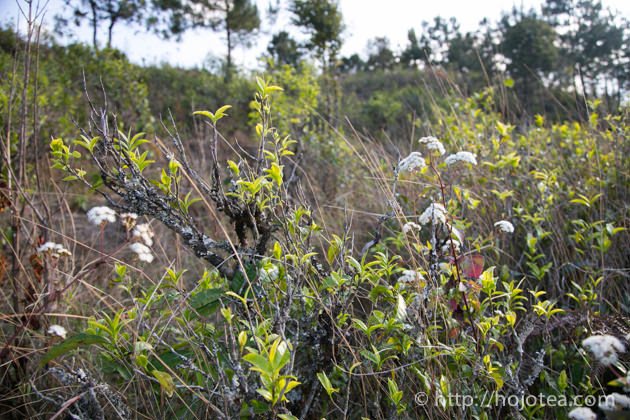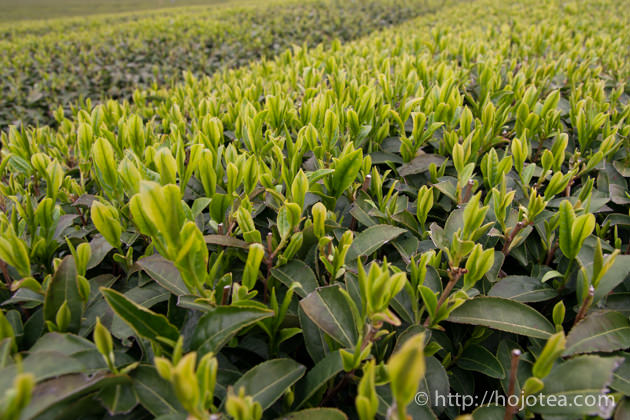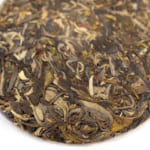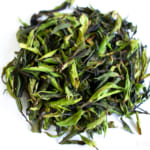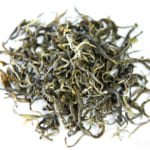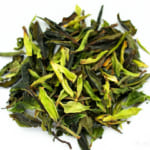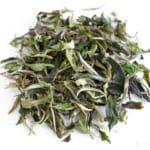- HOME >
- Tea constituents and functional effect
What is the ideal tea for fermentation and aging?

The freshly-plucked tealeaf has green leafy aroma. When the fresh tealeaf undergoes appropriate fermentation or maturation, its green leafy aroma will becomes fruity or floral note. The fermentation of tea refers to the enzymatic oxidation, while the maturation means non-enzymatic oxidation. However, even if it undergoes fermentation or maturation, not all tea produces fruity or floral note.
Terpene exists both in fruits and teas
For both fermentation and maturation, poly phenol is the main substance in developing floral or fruity flavor. Poly phenol contains benzene ring with more than two hydroxyl substitutes (-OH) in its molecule. The major poly phenol found in tea is catechin, catechin gallate, epigallocatechin gallate and etc. When tea undergoes fermentation or maturation, poly phenol is oxidized and produced the substance called terpene, which is a group of substance, and isoprene is its molecular unit. Terpene also commonly exists in fruits and flowers. It is the substance that gives so-called fruity or floral flavor. The reason why the flavor of oolong or black tea is similar to the fruit or flower is because of these teas contain exactly the same substance as in fruit or flower. For example, the citrus note of oolong is because of the substance called geraniol, which also exists in citrus fruit. Another common substance in tea is called rinalool, which also exists in lavender or Bergamot. These terpene compounds are produced when poly phenol is oxidized through enzymatic or non-enzymatic oxidation. In other words, the more poly phenol the tea contains, the more floral or fruity flavor it produces after fermentation or maturation.
The more fertilizer is given, the more amino acid is formed in tea
The poly phenol content in tea is reflected by the way of farming. I have studied the relationship between the dose of fertilizer and the amino acid or poly phenol content in tea. I found that the more fertilizer is applied, the less poly phenol is formed. The poly phenol content in natural farming tea (grown with completely no fertilizer) is about 3 times higher compare to ordinary tea that is grown with modern agricultural practice. On the other hand, the tea grown with plenty of fertilizer contains a greater amount of amino acid (e.g., theanine).
Umami gives no advantage in fermentation or maturation
In terminology of taste, the amino acid is called “Umami”. Umami in Japanese has two meanings, one is referring to the specific taste of amino acid and another meaning is delicious taste. Due to this confusing meaning, many Japanese misunderstood that the more umami, the better the taste and the better the quality. This misstatement is often seen in many tea articles too. In any case, talking about the fermented tea, the presence of too much amino acid and less poly phenol does not lead to the good outcome in flavor. Amino acid undergoes Maillard reaction when tea is enzymatically or non-enzymatically oxidized. The Maillard reaction is the oxidation between amino acid and either sugar or poly phenol.
Tea that is rich in poly phenol produces fruity or floral flavor
In the initial stage in the Maillard reaction, tea usually develops flavor which is slightly similar to the flavor of hot cake. However, after tea is aged for a long time, the flavor becomes a bit “fishy”, a typical smell of oxidized amino acid. It is due to the further oxidation and degradation of the nitrogen compound produced by the Maillard reaction. On the other hand, tea from natural farming practice contains very high poly phenol and low amino acid, and it will develops floral or fruity flavor as a result of long term storage. As for the aging of tea, pu-erh tea is the most famous and should be the well-known tea for aging. However, there are many other teas that give fruity or floral flavor if it is properly matured, such as Darjeeling, Oolong Tea and White tea. Even the Japanese green tea, tea will develop fruity flavor if it is well-matured under certain conditions. Most importantly, tea is rich in poly phenol. Many famous gardens in Darjeeling carry out the biodynamic farming that uses very less or no fertilizer for growing tea. That is why a number of Darjeeling teas have an intense fruity or floral flavor. On the other hand, generally Assam tea is grown with much more fertilizer than Darjeeling tea. It is one of the reasons that Assam tea often gives the aroma that reminds us of hot cake.
Tea with strong aftertaste contains a lot of poly phenol
If we compare between natural farming tea and tea grown with fertilizer, the natural farming tea gives stronger aftertaste. If we start applying fertilizer to the natural farming tea, it increases the production output but drastically reduces the aftertaste of tea. In a way, the poly phenol content is always in proportion to the aftertaste of tea. The lesser the nitrogen fertilizer is used, the higher the poly phenol content and eventually tea has stronger aftertaste. If less or no fertilizer, the number of tealeaf on the tree is decreased, the size of tealeaf becomes smaller and the growing speed also slower. In the end, each tealeaf of natural farming tea accumulates more minerals. If one hopes for their tea to be matured well, it is important to choose the tea with strong aftertaste.
Related Articles
How to get the latest update on HOJO?
1. Follow Twitter, 2. Click "Like" on Facebook, and 3. Subscribe in newsletter. You can have the latest tea news from HOJO.
 Subscribe the Newsletter to enjoy the privileges
Subscribe the Newsletter to enjoy the privileges- You may receive a free sample upon purchase, or you may have the priority to purchase special products. So please remember to subscribe our newsletter as well as the social network.
- Myanmar White Tea Bud 2013 from Guo Gan, Myanmar
- We have released a raw Pu-erh tea, 緬甸白芽茶 2013 (Myanmar White Tea Bud 2013), produced by ethnic minorities in t …
- Yong De Wild White Tea 2025 Loose Leaf Limited Release
- We have released Yong De Wild White Tea Loose 2025. For the 2025 harvest, only the loose-leaf type was …
NEW ARTICLES
 Myanmar White Tea Bud 2013 from Guo Gan, Myanmar
Myanmar White Tea Bud 2013 from Guo Gan, Myanmar- We have released a raw Pu-erh tea, 緬甸白芽茶 2013 (Myanmar White Tea Bud 2013), produced by ethnic minorities in t …
 Yong De Wild White Tea 2025 Loose Leaf Limited Release
Yong De Wild White Tea 2025 Loose Leaf Limited Release- We have released Yong De Wild White Tea Loose 2025. For the 2025 harvest, only the loose-leaf type was …
 Experience the True Freshness of Raw Pu-erh : Tang Jia 2025 Loose Leaf Release
Experience the True Freshness of Raw Pu-erh : Tang Jia 2025 Loose Leaf Release- We have released Tang Jia Raw Pu-erh Tea 唐家古樹生茶 2025 Loose Leaf. Among HOJO’s raw pu-erh teas, Tang Jia Raw Pu …
 Yunnan Chun Jian Green Tea from High Mountain Gardens
Yunnan Chun Jian Green Tea from High Mountain Gardens- Yunnan Chun Jian Green Tea is now available. This tea is made from naturally grown leaves harvested from high …
 Limited Loose Leaf Release of 2025 Da Xue Shan Wild Raw Pu-erh Tea
Limited Loose Leaf Release of 2025 Da Xue Shan Wild Raw Pu-erh Tea- We have released the 2025 loose-leaf version of Da Xue Shan Wild Raw Pu-erh Tea. This tea comes from wild tea …
 Discover a New Way to Enjoy Tea: Cooking Rice with Tea
Discover a New Way to Enjoy Tea: Cooking Rice with Tea- Cooking rice with tea is a simple idea, but it brings surprisingly satisfying results. The tea’s flavour seeps …
 2025 Da Xue Shan Wild White Tea Now Available from Yunnan
2025 Da Xue Shan Wild White Tea Now Available from Yunnan- The 2025 harvest of Da Xue Shan Wild White Tea is now available. Crafted from truly wild Camellia taliensis tr …
 Fresh 2025 Yunnan White Tea – Select Your Favourite Lot Before Blending
Fresh 2025 Yunnan White Tea – Select Your Favourite Lot Before Blending- Freshly crafted in Yunnan and just arrived in KL, our new 2025 white tea is now available at our Gardens Mall …
 2024 Dong Shan Raw Pu-erh Tea – Crafted with the Producer for Desired Quality
2024 Dong Shan Raw Pu-erh Tea – Crafted with the Producer for Desired Quality- We have released the 2024 cake of Dong Shan Raw Pu-erh Tea. Earlier, we offered the loose-leaf version from th …
 Development of Firewood Roasted Hojicha Using Naturally Grown Tea from Yunnan
Development of Firewood Roasted Hojicha Using Naturally Grown Tea from Yunnan- We are currently staying in Yunnan Province for tea production. As the season nears its end, tea trees with pa …
Category
- New Arrival at HOJO Online Shop
- Featured Articles
- Newsletter
- Types of Tea
- Origin of Tea
- Teapot and Tea Equipment
- Tea Column
- How to enjoy tea
- Tea Processing
- How to choose quality tea
- Tea constituents and functional effect
- Safety of Tea
- Foods
- Tea Business Operation
- Hobby and Outdoor Activity
- Ranking of Tea
- Video
- FAQ
- Media Release
Profile

- AKIRA HOJO
- I invite you to experience my tea selections.I was born in Nagano, Japan. In university, I studied agricultural chemistry, and I have the master degree in food science. I worked in Japanese food industry for 10 years. I involved in R&D, QC and QA. As a factory manager, I implemented ISO9000 series and managed the factory.
- The Art of Tea Magazine
- We posted the article on “The Art of Tea Magazine No.9, the magazine is published in Taiwan. We featured …
- New Straits Times
- The Malaysian National Newspaper, New Straits Times featured HOJO Tea on 17-Oct-2007.
Shop Info

Address:Lot No. T-215, 3rd Floor, The Gardens Mall, Mid Valley City, Lingkaran Syed Putra, 59200 Kuala Lumpur
Tel: +603-2287-4537
Business Hour: 10am to 10pm

